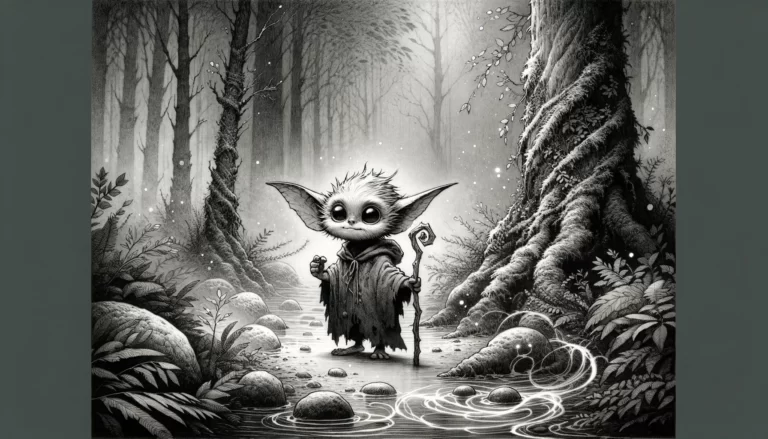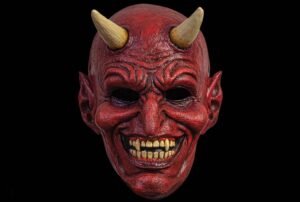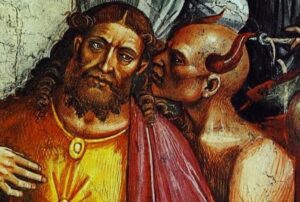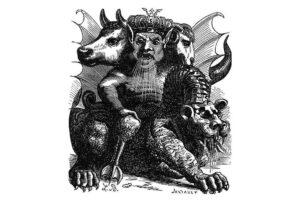Table of Contents
A mythical creature, often portrayed as a small, mischievous demon or sprite in various folklore and mythology, is an imp. These supernatural beings exhibit a playful and sometimes malicious nature, frequently engaging in pranks or causing minor disturbances. The concept of imps exists in diverse cultural traditions, with variations in their appearance and behavior.
Imps, commonly associated with the devil in Western folklore, may serve as his minions, carrying out nefarious deeds on his behalf. Their small size enables them to go unnoticed as they sow chaos and confusion. Despite their mischievous nature, people do not typically consider imps inherently evil but rather mischievous tricksters.
Origin of Imps

Imps originated in Germanic folklore, initially described as “lesser goblins.” In English folklore, they adopted their current name from the old English word “ympa,” signifying an “offshoot of a tree.” This name reflected their status as lesser beings, often under the control of more powerful and darker forces.
Appearance
Size: Imps are typically portrayed as small creatures, often dwarf-like in stature.
Horns: Some depictions feature imps with small horns on their heads, giving them a devilish appearance.
Pointed Ears: Like many fantasy creatures, imps may have pointed ears, adding to their supernatural aesthetic.
Wings: Some myths describe imps as winged creatures, allowing them to move swiftly and stealthily.
Tail: Imps are often depicted with tails, which can be long or short, and may be forked or have other distinctive features.
Skin Color: The skin color of imps can vary, but they are commonly depicted as red or another vibrant color associated with the supernatural.
Facial Features: Imps may have exaggerated or expressive facial features, including large eyes, sharp teeth, and impish grins.
Clothing: In some stories, imps wear tattered or ragged clothing, adding to their scrappy and mischievous appearance.
Behavior
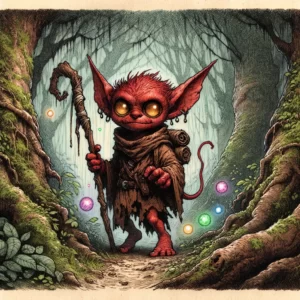
Mischievous Behavior: Imps frequently engage in mischievous and playful trickery, causing trouble for humans and other creatures. However, their pranks are usually more annoying than harmful.
Magical Abilities: Imps possess magical powers, employing them for their mischievous deeds. These abilities encompass shape-shifting, invisibility, and the capacity to create illusions.
Service to a Higher Power: In some traditions, imps serve more powerful supernatural beings, such as demons or witches. They undertake tasks or perform tricks on behalf of their masters.
Temptation: Imps, at times, associate with temptation, attempting to lead individuals astray or encouraging them to partake in mischief or wrongdoing.
In certain folklore, imps form pacts with humans, involving the exchange of services. The imp provides assistance or magical abilities in return for something from the human, such as their soul.
Some stories suggest that specific symbols or objects, such as protective amulets or magical circles, can repel or control imps.
While possessing magical abilities, imps are often portrayed as physically weak or small. They rely on their cunning and magical talents rather than brute strength.
How to fight Imp
In the realm of folklore, protective symbols like talismans guard against imps. Charms and symbols ensure safety.
Magical circles act as barriers, impeding imps’ entry. These circles are vital in dealing with supernatural entities.
Invoke purity, holiness, or a higher power’s name to repel imps. Religious symbols and rituals play a crucial role.
In tales, pacts with imps exist. Breaking contracts or finding loopholes frees one from imp influence.
Outsmart imps using cleverness. Solve riddles, find loopholes, and use wit when facing these tricky beings.
Professional help, sought by troubled individuals, involves wizards, shamans, or priests. They deal with supernatural entities.
Transitioning from these mythical themes to reality, remember, there’s no need to worry about mythical creatures.
Mhyts and similarities

European Folklore:
Brownies and Hobgoblins: In English and Scottish folklore, creatures like brownies and hobgoblins share similarities with imps. Brownies are helpful household spirits, while hobgoblins can be mischievous but may also aid in household chores.
Kobolds: Germanic folklore includes kobolds, who are household spirits with both helpful and mischievous traits. They are known for playing pranks but can also assist with tasks.
German Folklore:
Rübezahl: In Central European folklore, Rübezahl is a mountain spirit known for his capricious nature. While not precisely an imp, Rübezahl shares some characteristics, such as playing tricks on humans.
Scandinavian Folklore:
Nisse/Tomte: In Scandinavian folklore, the Nisse (Norway/Denmark) or Tomte (Sweden) associates with farms and households. Their behavior varies based on how people treat them—helpful or mischievous.
Celtic Folklore:
Leprechauns: In Irish folklore, leprechauns are often considered a type of fairy or imp. They are known for their shoemaking skills and are mischievous, especially when it comes to protecting their pots of gold.
Slavic Folklore:
Domovoi: In Slavic folklore, the Domovoi is a household spirit that can be benevolent or mischievous. They are believed to protect the home but may cause trouble if angered.
FAQ
What is their role in folklore?
In folklore, imps are associated with mischief and may serve as minions to the devil, carrying out nefarious deeds.
Can imps form pacts with humans?
Yes, according to certain folklore, imps may form pacts with humans, offering assistance or magical abilities in exchange for something.
How can one protect against imps?
Protective measures include using warding symbols, creating magical circles, invoking purity or holiness, and seeking professional help from knowledgeable individuals.
Are imps considered inherently evil?
Despite their mischievous nature, imps are not typically considered inherently evil but rather mischievous tricksters in folklore.
Do imps have physical strength?
Imps are often portrayed as physically weak or small, relying on their cunning and magical abilities rather than brute strength.
